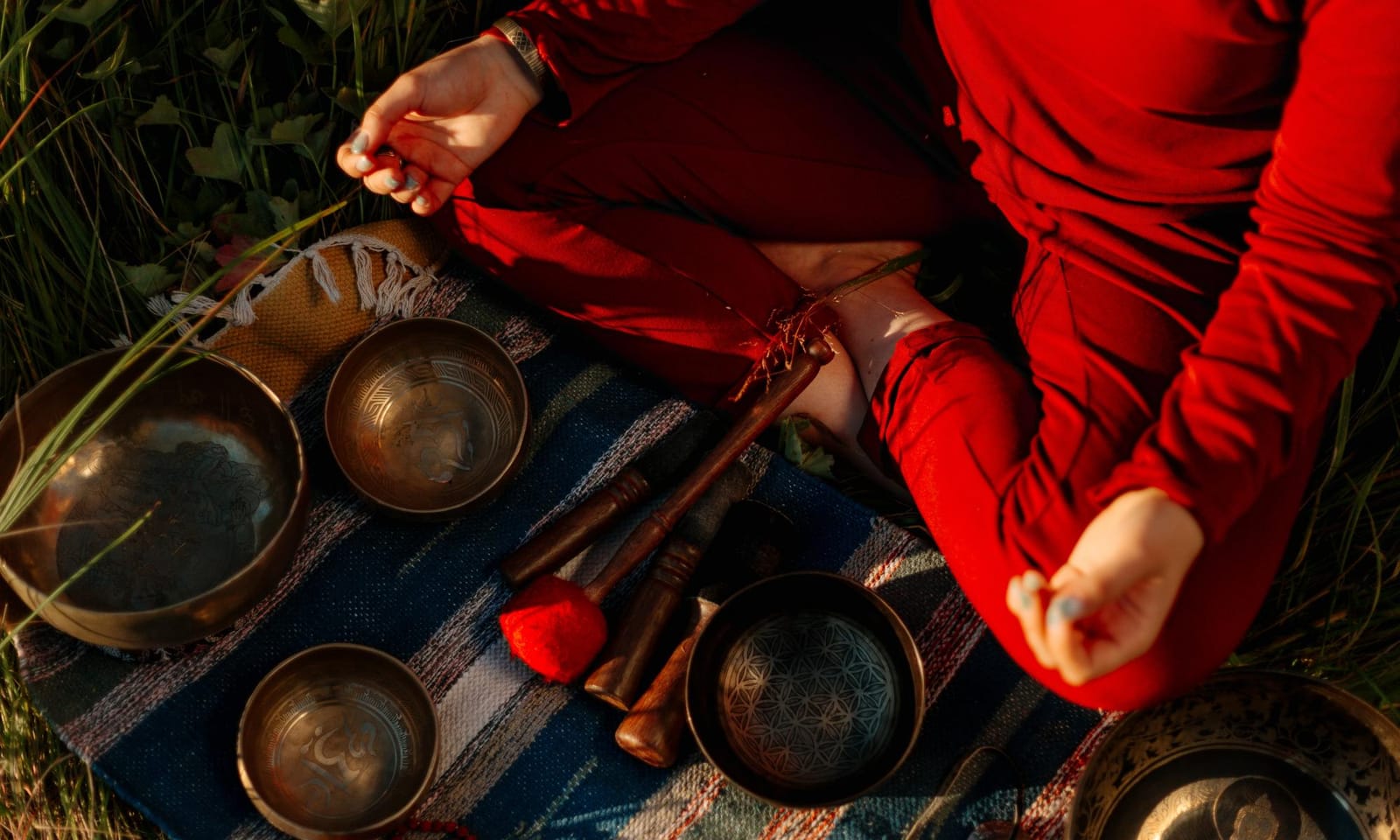
'Mansik swasthya' is the closest translation of "mental health" in Hindi. But that's not a phrase that my Indian ancestors would have used, as mental health wasn't exactly "a thing" back then. And yet, I am slowly realising that my ancestors had so much to teach us about mental wellbeing. They were the founders of yoga, meditation and Ayurveda. They cooked with ingredients and spices which had healing and medicinal properties. They valued community and social connection, and believed that it takes a village to raise a child.
In all honesty, my Indian culture is not something I have generally associated with positive mental health. India has a lot of room for improvement when it comes to mental health, and some of the culture's societal expectations and norms are not particularly conducive to mental wellbeing. This includes gender-based stereotypes, patriarchal structures/systems, inequality and poverty, the caste system, the stigma or shame associated with depression or anxiety, and pressures to marry—not to mention the community gossip and scrutiny (I could insert a few meme-worthy desi or local aunties here). In addition, traditional Indian family dynamics do not promote vulnerability or open communication about one’s feelings or problems.
However—provided I do so respectfully—I think it's possible to reject or choose not to take on board certain aspects of my culture, while also digging deeper and finding those ancestral jewels of mental health wisdom. While modern India may have moved away from its roots to some degree, I remind myself of the kinds of practices that my ancestral bas and bapujis (fore-mothers and fore-fathers) would have adopted. I can see how we might incorporate those things into 21st century life in small, yet meaningful ways.
Being born in New Zealand, I have experienced a sense of disconnection from my Indian heritage for the majority of my life. This may have been due to my own lack of interest or ignorance, some internalised racism or a combination of these factors. But now that I'm older, I am so much more curious about my Indian culture: the food, the practices, the old-school ways of doing things. I enjoy listening to my dad talk about growing up in Bombay (now Mumbai) and Gujarat (the west coast state of India where my family originates), the nickname his neighbours would call him, the kinds of jokes he and his school friends made. I appreciate how different his childhood was from mine. I like dressing up in chaniya cholis (traditional Gujuarati top and skirt outfits) and saris. I still have a long way to go, having only scratched the surface of learning about and embracing my culture. My Indian ancestors’ knowledge of mental wellness and general wellbeing is part of my newfound appreciation.
There are of course some balances to be struck. I want to be more in tune with my cultural roots while also staying true to my Kiwi upbringing and identity. I want to achieve positive change while also being realistic. I want to deepen my understanding of my culture but also become more aware of the difference between cultural appreciation and appropriation, especially as I recognise how my knowledge of Ayurvedic practices has been influenced by a Western perspective.
Ayurveda, yoga; these are familiar words. Indian cultural knowledge has been so pivotal in the wellness space. Yet, the rediscovery of those practices has also been a little unsettling. It has become commonplace for Indian culture to be appropriated within the health and wellness industry, including the social media influencer space. In the last few decades, the core of Ayurveda has been commodified and packaged as part of Western wellness and spa culture. The traditional practices have been diluted in exchange for a trendy, consumer-friendly version. Yoga and meditation studios are everywhere but often fail to acknowledge the origin and essence of their practices. Chai lattes are happily sipped but nobody talks about where chai actually comes from. How can seekers distinguish between cultural appropriation and appreciation, always striving for the latter? The distinction requires adopting this powerful ancestral knowledge while simultaneously showing care and appreciation for its origin.
Ayurveda: the science of life
Manas Kshirsagar, is a National Ayurvedic Medical Association (NAMA) Board -certified Ayurvedic doctor based in California. He is particularly well-placed to bring Indian practice into dialogue with Western habits. Kshirsagar often jokes that he was born to speak about mental health because his first name, Manas, means "mind" in Sanskrit; the ancient language of India.
Kshirsagar was exposed to Ayurveda at an early age as the son of two Ayurvedic physicians. While he originally pursued conventional, science-based medicine during medical school, he later decided that he preferred the more personal, holistic approach to medicine that his parents were practising.
Ayurveda is an ancient form of holistic medicine, believed to have originated in India as much as 53,000 years ago. It is both preventative and treatment-focused, and involves living in a way that helps restore balance. The term ‘Ayurveda’ means "the science of life" in Sanskrit , and the practice has been widely adopted across the West.
Kshirsagar notes that in Western research and discourse surrounding mental health, there tends to be a perception of the mind as a distinct entity, separate from our physical selves. In contrast, Ayurveda recognises the inseparable connection between the body, mind, and spirit, considering them as intricately intertwined aspects of our overall wellbeing. According to Kshirsagar, Ayurveda is a way of "treating the body to cure the mind, and treating the mind to cure the body." Hence, while a lot of Ayurvedic practices might be physical ones, they are also treating the mind. By addressing both the body and mind, Ayurvedic practices contribute to achieving comprehensive, holistic wellness for individuals.
Ayurveda is rooted in the five elements of nature—ether or space, air, fire, water, and earth—and the fundamental belief that humans are composed of these elements. In line with this understanding, Kshirsagar says that "the easiest way to practice Ayurveda is to live in accordance with nature." When we are unable to align with nature's rhythm, there are consequences. He highlights how our bodies naturally release different hormones at specific times of the day, following our innate circadian rhythm. If we don't listen to the messages those hormones are sending through our bodies, "that's where the imbalance happens."
There are a few ways to live in accordance with nature. Kshirsagar suggests sleeping and rising with the natural sun cycle if possible, in the way that birds do. There is a natural melatonin release when the sun goes down, so he advises clients who are having trouble sleeping to watch the sunset. Other recommendations include stretching first thing in the morning, akin to a waking cat, minimising screen time before bed to prevent disruption of the natural circadian rhythm caused by screen light, and eating lunch—preferably the largest meal—between 10:00 am and 2:00 pm.
According to Ayurveda, different combinations of the five elements of nature create the three fundamental life energies, or doshas. These are Vata (movement), Pitta (digestion or metabolism) and Kapha (lubrication and structure). Kshirsagar provides insights into the three doshas and their corresponding characteristics. Vata types are usually individuals who are naturally slender, expressive, creative, and outgoing. However, they are prone to suffer from worry, anxiety, and fear, and generally need more sleep than other dosha types. Kapha types typically have a heavier build, thick skin and thick hair. They are kind, loving, down-to-earth, generous and have a calm temperament. Weight loss can be challenging for them, and they tend to struggle with lethargy. Pitta types have fiery personalities. They are generally more muscular with sharp appetites. They can be critical, judgemental and irritable, while also being ambitious and driven.
While all three doshas exist to some extent in every individual, typically one or two doshas tend to be more dominant. Kshirsagar recommends either consulting a practitioner or using an online dosha quiz such as that found on the Chopra website to understand an individual’s mix of doshas. He also suggests asking a family member or close friend to do the quiz, as their objectivity might yield more accurate results.
Dinacharya: a daily Ayurvedic routine
Once a person identifies their dosha type, they can then look into maintaining a dinacharyam, or daily routine, that incorporates specific practices tailored to their dosha type. This page on the Chopra website provides some guidance on dinacharya, to create morning, afternoon and evening routines. The value of dinacharya can be seen in its continued, intergenerational cultural use.
While daily routines should be dosha-specific, an Ayurvedic morning routine generally incorporates most of the following five practices:
- Meditation: A 5-10 minute meditation session in the morning will awaken and clear the mind, and meditation is a calming way to start the day.
- Oil pulling: Swishing oil in the mouth helps to remove bacteria, whiten teeth and reduce toxins in the body.
- Tongue scraping: Use a stainless steel, gold, silver, copper, tin or brass scraper against the tongue after brushing. It helps to clear bacteria off the tongue, stimulate internal organs, improve digestion and cleanse the body by removing toxins from the mouth. In Ayurveda, the appearance of the tongue before tongue scraping provides valuable insight into a person's overall health, and some Ayurvedic practitioners examine the tongue as part of their assessment.
- Movement: A walk, yoga or daily stretching is a great way to start the day, get the blood moving and boost energy.
- Drink: To ignite the digestive fire, it is recommended to start the day by drinking warm water, optionally infused with ginger and lemon, or enjoy a cup of tea.
Other ways to construct Ayurvedic afternoon and evening routines, or at least to include some Ayurvedic, nature-derived practices that work for you can be found here.
Reflection is an essential practice to gain a deeper understanding of how your current routine may be negatively impacting your wellbeing. Take a moment to contemplate these modern habits: excessive screen time, reliance on quick meals comprising pre-cooked leftovers or processed snacks, staying up late and sleeping in on weekends, and irregular physical movement and exercise.
Modern norms include plenty of bad habits. Change begins by accepting that our modern lifestyles and demands have limitations and pressures. Ayurveda isn’t a pretext for self-condemnation: the goal is to tweak bad habits rather than expecting unrealistic, total change. As Kshirsagar says, "Nobody is ever good at meditation, nobody is ever good at yoga, nobody is ever good at Ayurveda. Everybody is just practising . . . that's why they're called practices."
Abhyanga (self-massage)
Abhyanga (self-massage) is another recommendation in Ayurveda, to be done prior to showering or bathing. The best oil to use will depend on a person's dosha type, but Kshirsagar suggests using sesame oil, or coconut oil in the summertime.
Abhyanga has various benefits, including a feeling of stability and warmth, calming the nerves, improving sleep and increasing circulation. While receiving a massage is very relaxing and therapeutic, Kshirsagar notes how the act of massaging oneself is a form of self-love, and helps a person build a stronger relationship with themselves. That connection with oneself is super beneficial to improve mental health and overall wellness.
Yoga and meditation
Yoga and meditation have many benefits for the body and the mind. They are a key part of the Ayurvedic experience. Kshirsagar asserts, "You can't talk about yoga or meditation without talking about Ayurveda, and you can't talk about Ayurveda without mentioning yoga and meditation. They're called sister sciences for that reason." Kshirsagar notes that yog means union, with yoga involving that union of mind, body and spirit which is consistent across Ayurveda, meditation and yoga.
Both yoga and meditation are now ubiquitous around the world. Those who regularly practise yoga and meditation will have an appreciation for their physical and mental health benefits. Others may acknowledge the benefits, but perhaps they haven't engaged very often. Some might be what Kshirsagar refers to as "crisis meditators" or people who only meditate before a potentially stressful event.
It's important not to create further anxiety and stress by putting pressure on ourselves. As with the dinacharya (daily routine) and Ayurveda in general, the goal is not to achieve total change. The goal is to make consistent tweaks and gradual, realistic improvements. With various online resources available such as Headspace, Insight Timer or YouTube videos, almost anyone can try meditation and yoga from the comfort of their own home.
The thali (plate)
A traditional Indian diet is inherently balanced, emphasising quality protein, vegetables, and gut health while incorporating healthy fats. The traditional Indian thali consists primarly of plant-based ingredients such as grains, lentils, vegetables, dairy, spices, prebiotics and probiotics, and fats. In line with the principles of Ayurveda, meals are recommended to include all six tastes or rasas: sweet, sour, salty, bitter, pungent, and astringent. These rasas correspond to different flavors and have unique effects on the body and mind. For example, sweet promotes nourishment and satisfaction, sour enhances digestion, salty supports mineral balance, bitter aids in detoxification, pungent stimulates metabolism, and astringent promotes balance and contraction. The traditional thali aims to achieve a harmonious balance of all these tastes, providing a holistic dining experience. Research suggests that ancestral dietary practices (including this balanced plate) can support paediatric diabetes management as well as have a positive impact on conditions such as cardiovascular diseases, obesity, metabolic disorders, gastrointestinal ailments, inflammatory conditions, and other chronic illnesses.
In today's world of processed foods and meat consumption, using the Indian thali as inspiration for one’s eating practices can be an important key to overall wellness. Kshirsagar also emphasises the need to eat mindfully: "There's a reason we eat with our hands in Vedic culture—to connect you with yourself. Not sitting in front of the TV, mindlessly eating."
Spices are generally considered the defining feature of Indian cooking. Both within Ayurveda and generally, the traditional Indian diet includes food, herbs and spices which have healing and medicinal properties. They are ingredients that Indians use to this day to make their food flavoursome, colourful and healthy. The following herbs and spices within the Indian/Ayurvedic diet are notably beneficial to the mind, body and soul:
- Haldi (turmeric) has been a staple of the Indian diet for centuries. Research shows that curcumin, the main active component in turmeric, could be a promising option in the management of Major Depressive Disorder (MDD). Turmeric can be incorporated into daily meals by adding it to curries, soups, or vegetables, harnessing its therapeutic properties. Additionally, turmeric shots and turmeric face masks have gained popularity for their potential wellness benefits. By embracing the versatility of turmeric, individuals can explore its potential role in supporting mental health and overall wellbeing.
- Tulsi (holy basil) is a herb which has calming properties and is very good for cognitive function. Tulsi can be steeped in hot water to make a tea-like beverage. Alternatively, tulsi tea bags can also be bought in stores.
- Brahmi (water hyssop) is a herb that, research shows, can help with generalised anxiety disorder. There are different ways to use brahmi, such as taking it as a supplement or using it in the cooking process.
- Ashwagandha (Indian winter cherry) is believed to provide various health benefits including helping to reduce stress and anxiety, and improving energy levels, sleep and concentration.
Concluding with a cup of chai
You can't talk about an Indian diet without mentioning masala chai (a tea of mixed spices). Masala chai contains spices which have anti-inflammatory properties and a range of benefits including boosting immunity, helping to manage fatigue, and improving digestion. Every Indian family has its own secret recipe for the masala that goes into masala chai, and every Indian family thinks that their chai is the best! My parents' recipe was passed down from my grandparents and contains six key spices, including cinnamon and elaichi (cardamom).
Masala chai also has social significance. In my hometown of Navsari, Gujarat, friendly village ladies would often stroll past my family home, asking the rhetorical question in Gujarati, "Kem cho, chai peedhi ke?" This simple phrase, which translates to "have you had your cup of tea?" was much more than a literal inquiry. It's was a check-in, an attempt to make conversation and a way to foster a sense of community.
I'm finally making an effort to improve my mental health and overall wellbeing by doing away with some of the bad habits and adopting traditional techniques and ways of living—while still catering to the demands of modern life. I've realised that my Indian ancestors have much more to offer than I originally thought. I want to explore these practices in a gradual yet purposeful way, tap into this knowledge and be open to learning from those directly around me.
In today's world, there is a shared pursuit among many individuals to attain a sense of balance and overall wellness. Ayurveda, with its profound wisdom and traditional Indian practices, holds the potential to fulfill this quest. It is crucial, however, to approach Ayurveda with appreciation rather than appropriation, recognising the valuable health and wellness insights it offers as a precious treasure chest waiting to be explored.







